A mass for asymptotically complex hyperbolic manifolds
A mass for asymptotically complex hyperbolic manifolds
A mass for asymptotically complex hyperbolic manifolds
Create successful ePaper yourself
Turn your PDF publications into a flip-book with our unique Google optimized e-Paper software.
hal-00429306, version 1 - 2 Nov 2009<br />
6 A MASS FOR ASYMPTOTICALLY COMPLEX HYPERBOLIC MANIFOLDS.<br />
<strong>for</strong>mula, then leads to<br />
(5)<br />
∇ g ψ ˜<br />
i<br />
+<br />
2 ˜ <br />
2<br />
ψ<br />
+ 1<br />
4 (Scalg<br />
<br />
<br />
− ScalgRHn) ˜ <br />
<br />
ψ<br />
2<br />
<br />
M<br />
<br />
= lim ...<br />
R→∞ SR<br />
The right hand side can be computed explicitly : it is<br />
µg (QRHn(ψ)) = −1<br />
4 lim<br />
<br />
∗ (div g + dTr g) |ψ|<br />
R−→∞ SR<br />
2<br />
− Tr(g − gRHn)du + (g − gRHn)(d |ψ|2 <br />
,.) ,<br />
where the sphere, the Hodge star, the divergence, the trace and the identification<br />
between vectors and <strong>for</strong>ms on the right-hand side are taken with respect to gRHn. Since N +<br />
RHn ⊂ QRHn(KRH n), it follows that µ yields a linear functional on the linear<br />
span of N +<br />
RHn, namely on NRHn ∼ = Rn,1 . In view of (5), it is clearly non-negative on<br />
N +<br />
RHn. Besides, if µ vanishes, the left-hand side of (5) is zero, so that every ˜ ψ is a<br />
Killing spinor on (M,g) ; then, in view of (4), <strong>for</strong> any element σ = QRHn(ψ) +<br />
of N RHn, there is an element ˜σ = Qg( ˜ ψ) of Ng that is asymptotic to σ. As a consequence, Ng<br />
has maximal dimension, which implies that (M,g) is (locally) <strong>hyperbolic</strong>. In view of<br />
its asymptotic, it is bound to be RH n .<br />
Theorem 1.1 ([CH]) — Let (Mn ,g) be an <strong>asymptotically</strong> <strong>hyperbolic</strong> spin manifold,<br />
with Scalg ≥ ScalgRHn. Then the linear functional µg on NRHn introduced above is welldefined<br />
up to an automorphism of RHn , it is non-negative on N +<br />
RHn and it vanishes iff<br />
(Mn ,g) is isometric to RHn .<br />
The fact that the orbit of µg under the action of O + (n,1) does not depend on the<br />
chart at infinity is not obvious but is proved in [CH]. Under our assumptions, µg may<br />
take infinite values (i.e. <strong>for</strong>mula (5) may be +∞ <strong>for</strong> some ψ) and this does not depend<br />
on the chart at infinity, so we actually obtain an element of (NRH n)∗ /O + (n,1) ∪ {∞}.<br />
Remark 3. The standard positive <strong>mass</strong> theorem, about <strong>asymptotically</strong> Euclidean metrics,<br />
can be thought of in a similar way. Let M be a spin <strong>asymptotically</strong> Euclidean<br />
manifold with non-negative scalar curvature. Witten’s trick consists in trying to build<br />
parallel spinors ˜ ψ on M that are asymptotic to the constant spinors ψ of the Euclidean<br />
space R n . Now every constant one-<strong>for</strong>m on R n can be written as X ↦→ i(X · ψ,ψ).<br />
So the rigidity part of the Euclidean positive <strong>mass</strong> theorem can be explained as follows<br />
: starting from a constant one-<strong>for</strong>m α on R n , we pick a constant spinor ψ such that<br />
α(X) = (X ·ψ,ψ) ; an analytical argument (based on µg = 0) provides a parallel spinor<br />
˜ψ on M asymptotic to ψ, hence a parallel one-<strong>for</strong>m ˜α, given by ˜α(X) = (X · ˜ ψ, ˜ ψ), that<br />
is asymptotic to α ; this yields a parallel trivialization of the cotangent bundle of M, so<br />
M is flat and is there<strong>for</strong>e R n , owing to its asymptotic shape. The <strong>mass</strong> is the obstruction<br />
to do this. It is a single number µ, but if we wish to make it fit into our picture,<br />
we might as well interpret it as a linear functional on the space of parallel sections of<br />
the flat bundle ER n := T ∗ R n ⊕ R : (α,u) ↦→ µu. The bundle EM := T ∗ M ⊕ R, endowed<br />
with the Levi-Civita connection on T ∗ M and the flat connection on the R-part, is of<br />
course flat if and only if M is flat, so the <strong>for</strong>malism described above still works.<br />
2. A <strong>complex</strong> <strong>hyperbolic</strong> connection.<br />
2.1. The connection. Let (M m ,g,J) be a Kähler manifold of <strong>complex</strong> dimension m.<br />
We wish to introduce a “<strong>complex</strong> <strong>hyperbolic</strong> connection” characterizing the <strong>complex</strong>


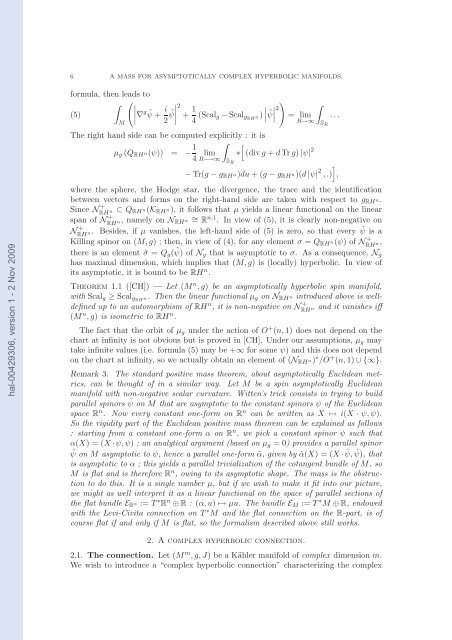

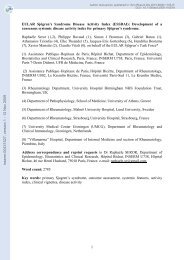
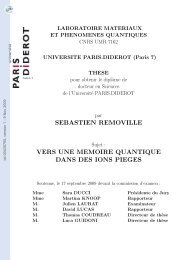
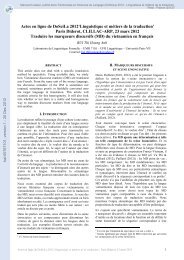
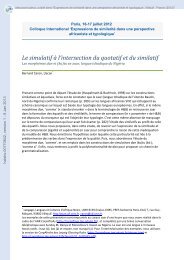
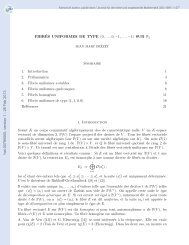
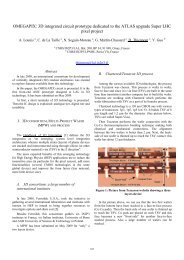
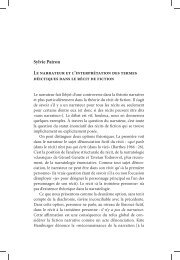
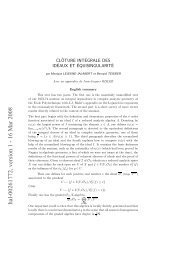
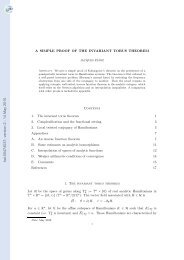

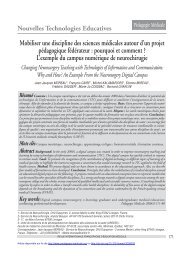

![[tel-00433556, v1] Relation entre Stress Oxydant et Homéostasie ...](https://img.yumpu.com/19233319/1/184x260/tel-00433556-v1-relation-entre-stress-oxydant-et-homeostasie-.jpg?quality=85)